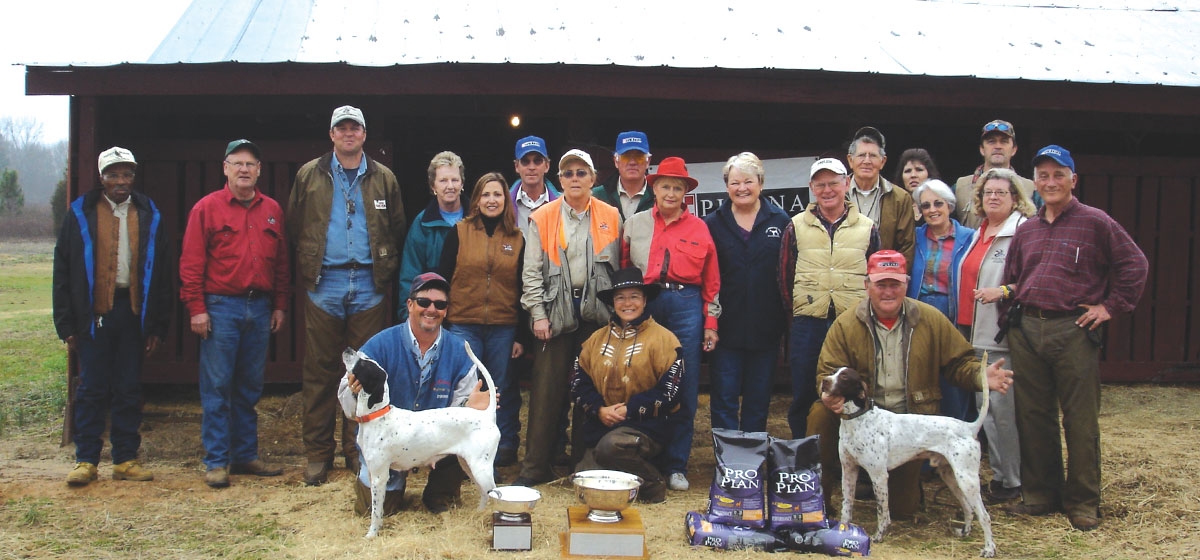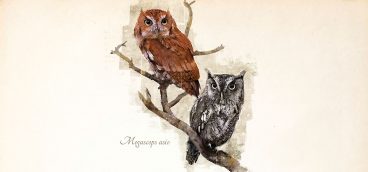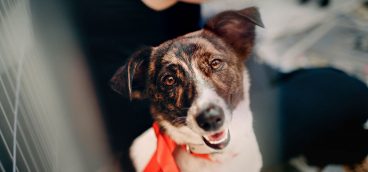A Tall Tail

It might be on the desolate plains of North Dakota, a lowland plantation in South Carolina or a rolling field in Pennsylvania. Wherever, it doesn’t take a first-time bird hunter long to realize the majesty and value of a good English pointer. The indefatigable dog zigzags in a euphoric trance through fields of high stubble, fence rows and tree lines for a whiff of quail or pheasant.
The hunter trails behind on foot or horseback until he spies the motionless dog pointing at a bird. Dismounting behind the dog, the hunter walks, gun up, beyond the pointer until the flushed bird takes flight.
When the shotgun speaks, the dog remains frozen. If aim is true, the bird falls to earth, lost in the muted colors of the fall landscape. On command, the dog leaves his point to search for the fallen prey. He doesn’t return until his quarry rests gently in his jaws. Without the dog, the hunter wouldn’t find the hiding bird. Without the dog, he might search in vain for the bird he shot. More than the hunt, the festive game meal, and even the glorious fall day, what remains is the memory of the canine athlete.
People in the field trial game have distilled the experience to its essence. When the dog is on point, the “hunter” flushes the bird and fires a blank pistol shot. The thrill isn’t the kill. It’s brining the dog to the peak of instinct and training.
For Susan and Dr. Roger Duerksen of Squirrel Hill, that peak came earlier this year with Talisman, Susan’s three-year-old, liver- and white-colored pointer. The deep-chested 60-pounder won the Kentucky Derby of the field trial world, the National Open Shooting Dog Championship. The victory was reported in the glossy black and white pages of the 131-year-old weekly newspaper, “American Field,” which carries the tagline, “The Sportsman’s Newspaper of America.”
The breed widely acknowledged as the best bird dog in the world traces its origin to the 17th century, when Spanish pointers were mixed with greyhounds for speed, bloodhounds and foxhounds for scent and bull terriers for tenacity. It was perfected by the English and made its way to the U.S. in the early 1800s. The most famous American breeder was the Elhew Kennels with Elhew being the name of Genesee Beer heir Bob Wehle spelled backward. And it was from Wehle that Susan Duerksen purchased her first bitch, 20 years ago.
She had a horse growing up in Carnegie and always loved dogs. Her marriage to Dr. Duerksen, a Midwestern outdoorsman, introduced her to upland game hunting, first with Brittany spaniels and then with pointers. Many dogs later, she bought Talisman, who was sired by Santos Blue Note and “out of” Southbound Sarah. Duerksen bought the 1-year-old for $3,500 because of “A look in his eye.” Such looks, she added, can be fleeting, though. And Talisman, who’d had very little training, was far behind his peers. Handler Mike Tracy wondered if he could make the dog a competitor.
In the field trial realm, though, Tracy’s pedigree was better than Talisman’s. His grandfather, Gerald Tracy, is in the Field Trial Hall of Fame, and his father, George, has won more championships than anyone. The young Tracy was 28 when he took on Talisman. The six-foot native of Glenville, Pa., rose at 5 a.m. every morning to work the dog in his blue jeans, T-shirt and ball cap.
Susan Duerksen described the process: “First, you need to handle puppies constantly. Hold them. Talk to them. Make them feel safe and secure and loved.” Then the teaching begins, letting them run and get a sense of independence but always under guidance. Next comes introduction to a seasoned horse who’s careful not to step on the young dog. Soon the puppy is running with the horse and learning the commands. “Here” and “Come” are important, but nothing compares with “Whoa.” The dog will point on instinct. “Whoa” comes into play when teaching the dog to be “steady to wing and shot.” Wing means when the bird flies, and the dog must learn to remain motionless. Likewise, when the gun is fired. Only when the master taps them on the back of the head is the dog released to find the bird.
As with people, success is a matter of breeding, training and luck. Sometimes a young dog becomes gun shy when someone shoots too close. It’s also important to have good manners. For instance, no crowding the bird. As soon as he scents a bird, he should go into his point and remain there. Pheasants can be a challenge in that way, because they creep and run around, and a young dog wants to follow
Judging dogs is an art that defies certainty but relies on guidelines, experience and feel. A dog must catch the eye of the judge, make him sit up in his saddle and take notice. The dog must keep his head high. That’s not only for looks. Unlike hounds, which follow scents from the ground, Pointers catch a whiff from the air. The tail must be “up and cracking,” which appears to mean wagging frantically. The dog should remain in front of the handler, even when the course turns and he is a 1/2 mile away. In a trial, handlers follow the dogs. Twenty yards behind the handlers are judges on horseback, and 10 yards behind them are scores of onlookers. A natural front-running dog, which Talisman is, will hear his handler’s call and remain in front. Beyond that, it’s all about finding birds, keeping points and not tiring.
Under Tracy’s tutelage, the sweet-tempered Talisman came along, kept his glint and started winning.
Most competitions last an hour, but the National Open Shooting Dog Championship is a grueling 90 minutes running on sand. One of Duerksen’s earlier dogs came close but lost it with three minutes left by “running over a bird.” If the dog breaks point, goes after the bird or chases it, it’s an immediate DQ. “Pick him up,” the judge will say. It happens mainly with young dogs, but even the best can falter.
Part of winning depends on the luck of the draw. In a weeklong trial, your dog may draw a day with rain, hail or snow and not have the same chance as a dog who runs on a mild day when birds are active and scent is in the air. The dogs compete in pairs in what’s called a brace. In this year’s championship, Talisman’s draw wasn’t good. The birds fly in the early morning and late afternoon, and Talisman drew the 22nd brace, a mid-afternoon run when the birds were quiet. And the course he drew had shown fewer birds in the trial’s first days. To top it off, it rained for all but 10 minutes of Talisman’s trial.
He did have a good brace partner, however, a dog named Awesom Rail (sic), and from the start, both caught the judges’ eyes as the two searched the sedge fields, pines and blackjack oaks of the grounds in Hoffman, N.C. Rail made the first find. Then Talisman. It was back and forth, with each dog finding two birds. Talisman’s finds were perfect.
“Each time, he was real high and tight on both ends,” Tracy said. “And with both, there were coveys of quail right off the end of his nose.
“The only difference was the last 10 minutes,” Tracy said. “I just had more dog — Talisman just wore Rail out.” Only two finds worried Tracy, but he hoped the judges would take into account the ground the dogs covered as well as their points. They did, and Talisman bested the field of 62.
Duerksen was tending a sick dog and couldn’t be there, but when she got the call, she cried.
“He’s so beautiful on point, he takes your breath away,” she later said.
The victory brings a $10,000 purse, which goes to the handler. That amount is about what Duerksen estimates it costs “to campaign” a dog for a year. Her spoils include an oil portrait of the dog, a hand-tooled saddle marking the championship and a .410 shotgun. She’s breeding Talisman now, charging $750 for each breeding. She’s kept the fees “reasonable,” because, she said, “I believe in breeding the best with the best.” And not all in the sport have deep pockets. Three litters have been born so far.
A dog might compete for eight or nine years. And for a dog, that means eight or nine years doing what he or she loves. After the days of competition are finished, so is kennel life, Duerksen said, “All the old dogs come home to stay with us.”





